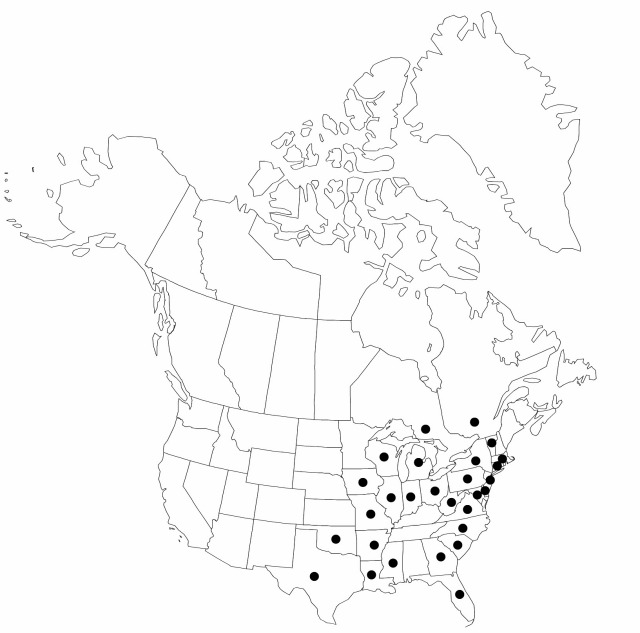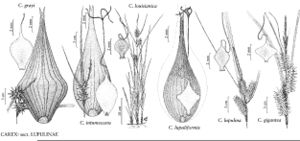Carex lupuliformis
Amer. J. Sci. Arts, ser. 2, 9: 29. 1850.
Plants loosely cespitose or not, long-rhizomatous. Culms solitary or not, erect, 50–130 cm. Leaves 4–7; basal sheaths brownish; sheath of distal leaf 3–21 cm; ligules rounded to triangular, 6–28 mm; blades 30–80 cm × 6–13 mm. Inflorescences 6–40 cm; peduncles of proximal spikes 1–13 cm, basal 2 peduncles 2–17 cm apart; of terminal spikes 1–12 cm, shorter than to somewhat exceeding the distal pistillate spike; bracts leafy, sheath 1–9 cm; blades 20–70 cm × 4–11 mm. Spikes: proximal pistillate spikes 2–6, the distal usually ± crowded, ascending, densely 8–90-flowered, usually cylindric, 2–8 × 1.5–3 cm; terminal staminate spikes 1–2, 2–10 cm × 2–5 mm. Pistillate scales 3–9 veined, lanceolate, 6–13 × 1.8–3.2 mm, apex acute to awned, awn rough, to 5.5 mm. Anthers 3, 3.5–7 mm. Perigynia ascending to spreading, strongly 17–25-veined, sessile, lance-ovoid, 12–18.5 × 3.8–6 mm, shiny, glabrous; beak conic, 6–9 mm. Achenes stipitate, rhombic, concave faces, angles thickened, prominently knobbed with hard, nipplelike points, 3–4.5 × (2.2–)2.4–3.4 mm; style same texture as achene.
Phenology: Fruiting late spring–summer.
Habitat: Wet forests, especially in openings around forest ponds, riverine wetlands, marshes, wet thickets
Elevation: 0–500 m
Distribution

Ont., Que., Ark., Conn., Del., Fla., Ga., Ill., Ind., Iowa, La., Md., Mass., Mich., Miss., Mo., N.J., N.Y., N.C., Ohio, Okla., Pa., S.C., Tex., Vt., Va., W.Va., Wis.
Discussion
Carex lupuliformis is rare and local throughout much of its range, especially northward.
Selected References
None.
